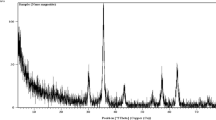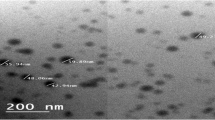Abstract
In this study, 336-day-old corn cob broilers were bought for the poultry experimental station during the months of May and June 2021. Before the arrival of chicks, the brooders, chick feeders, drinkers, humidity, temperature, and feeding management were controlled according to scientific patterns. These birds were randomly divided into seven groups and six replications of eight birds, viz. Group-A (positive control on basal diet only), Group-B (negative control on basal diet and HS), group-C (basal diet + simple Se 0.3 mg/kg feed), Group-D (basal diet + SeNP 0.3 mg/kg feed + HS), Group-E (BD + HS + chitosan), Group-F (BD + Se + COS), and Group-G (nano Se with chitosan 0.3 mg/kg + BD + HS). On the 42nd day of research, two birds were selected from each replication and sacrificed after blood collection. The initial data related to feeding intake, live body weight, and feed conversion ratio (FCR) were collected before slaughter. The intestinal samples were collected and immediately transferred to formalin after grass morphometry. The live body weight, FCR, feed intake, intestinal histomorphology, relative organ weight, and antioxidant parameters like MDA, SOD, and GPX were significant (P > 0.005) in all groups, with Group-G at the highest, followed by Groups-F, E, D, C, A, and B. Group-B (negative control group) was the most affected group in all aspects because of heat stress and only basal diet. It was concluded that heat stress highly causes a loss in performance, intestinal gross morphology, and histology in poultry, and increases stress conditions, whereas the selenium nanoparticle works to improve the body weight, FCR, and intestinal parameters.

Similar content being viewed by others
References
St-Pierre N, Cobanov B, Schnitkey G (2003) Economic losses from heat stress by US livestock industries. J Dairy Sci 86:E52–E77
Leon LR, DuBose DA, Mason CW (2005) Heat stress induces a biphasic thermoregulatory response in mice. American Journal of Physiology-Regulatory, Integrative and Comparative. Physiology 288(1):R197–R204
Mahmoud E-D Ijiri HD, Ebeid TA, Ohtsuka A (2016) Effects of dietary nano-selenium supplementation on growth performance, antioxidative status, and immunity in broiler chickens under thermoneutral and high ambient temperature conditions. J Poultry Sci 0150133
Zaboli G, Huang X, Feng X, Ahn DU (2019) How can heat stress affect chicken meat quality?–a review. Poult Sci 98(3):1551–1556
Lin H, Jiao H, Buyse J, Decuypere E (2006) Strategies for preventing heat stress in poultry. World’s Poult Sci J 62(1):71–86
Donkoh A (1989) Ambient temperature: a factor affecting performance and physiological response of broiler chickens. Int J Biometeorol 33(4):259–265
Saeed M, Babazadeh D, Naveed M, Arain MA, Hassan FU, Chao S (2017) Reconsidering betaine as a natural anti-heat stress agent in poultry industry: a review. Trop Anim Health Prod 49(7):1329–1338
Farooqi H, Khan M, Khan M, Rabbani M, Pervez K, Khan J (2005) Evaluation of betaine and vitamin C in alleviation of heat stress in broilers. Int J Agric Biol 5:744–746
Wang ZL (2001) Characterization of nanophase materials. Particle & Particle Systems Characterization: Measurement and Description of Particle Properties and Behavior in Powders and Other Disperse Systems 18(3):142–165
Thulasi A, Rajendran D, Jash S, Selvaraju S, Jose VL, Velusamy S, Mathivanan S (2013) Nanobiotechnology in animal nutrition, Animal nutrition and reproductive physiology (recent concepts), 1st ed.; Sampath KT, Ghosh J, Eds. 499-516
Tran PA, Webster TJ (2011) Selenium nanoparticles inhibit Staphylococcus aureus growth. Int J Nanomedicine 6:1553
Council NR, NRC. (1994) Nutrient requirements of poultry. National Academy Press, Washington, DC
Rinaudo M (2006) Chitin and chitosan: properties and applications. Prog Polym Sci 31(7):603–632
Xu Y, Shi B, Yan S, Li J, Li T, Guo Y, Guo X (2014) Effects of chitosan supplementation on the growth performance, nutrient digestibility, and digestive enzyme activity in weaned pigs. Czech J Anim Sci 59(4):156–163
Khambualai O, Yamauchi K, Tangtaweewipat S, Cheva-Isarakul B (2009) Growth performance and intestinal histology in broiler chickens fed with dietary chitosan. Br Poult Sci 50(5):592–597
Shi-bin Y, Hong C (2012) Effects of dietary supplementation of chitosan on growth performance and immune index in ducks. Afr J Biotechnol 11(14):3490–3495
Wang R, Liang R, Lin H, Zhu L, Zhang Y, Mao Y, Dong P, Niu L, Zhang M, Luo X (2017) Effect of acute heat stress and slaughter processing on poultry meat quality and postmortem carbohydrate metabolism. Poult Sci 96(3):738–746
Lu Z, He X, Ma B, Zhang L, Li J, Jiang Y, Zhou G, Gao F (2017) Chronic heat stress impairs the quality of breast-muscle meat in broilers by affecting redox status and energy-substance metabolism. J Agric Food Chem 65(51):11251–11258
Lara LJ, Rostagno MH (2013) Impact of heat stress on poultry production. Animals 3(2):356–369
Azad M, Kikusato M, Maekawa T, Shirakawa H, Toyomizu M (2010) Metabolic characteristics and oxidative damage to skeletal muscle in broiler chickens exposed to chronic heat stress. Comp Biochem Physiol A Mol Integr Physiol 155(3):401–406
Xu Y, Wang Z, Qin Z, Yan S, Shi B (2018) Effects of chitosan addition on growth performance, diarrhoea, anti-oxidative function and serum immune parameters of weaned piglets. South African J Animal Sci 48(1):142–150
Yang L, Tan G-Y, Fu Y-Q, Feng J-H, Zhang M-H (2010) Effects of acute heat stress and subsequent stress removal on function of hepatic mitochondrial respiration, ROS production and lipid peroxidation in broiler chickens. Comparative Biochem Physiol Part C: Toxicol Pharmacol 151(2):204–208
Dlouha G, Sevcikova S, Dokoupilova A, Zita L, Heindl J, Skrivan M (2008) Effect of dietary selenium sources on growth performance, breast muscle selenium, glutathione peroxidase activity and oxidative stability in broilers. Czech J Animal Sci 53(6):265
Aparna N, Karunakaran R (2016) Effect of selenium nanoparticles supplementation on oxidation resistance of broiler chicken. Indian J Sci Technol 9(S1):1–5
Surai PF (2002) Natural antioxidants in avian nutrition and reproduction, Nottingham University Press Nottingham
Cai S, Wu C, Gong L, Song T, Wu H, Zhang L (2012) Effects of nano-selenium on performance, meat quality, immune function, oxidation resistance, and tissue selenium content in broilers. Poult Sci 91(10):2532–2539
Aviagen T (2014) Ross 308 broiler nutrition specifications. Aviagen Group, Huntsville
Dhawan G, Singh I, Dhawan U, Kumar P (2021) Synthesis and characterization of nanoselenium: a step-by-step guide for undergraduate students. J Chem Educ 98(9):2982–2989
Boroumand S, Safari M, Shaabani E, Shirzad M, Faridi-Majidi R (2019) Selenium nanoparticles: synthesis, characterization and study of their cytotoxicity, antioxidant and antibacterial activity. Mater Res Express 6(8):0850d8
Safdari-Rostamabad M, Hosseini-Vashan SJ, Perai AH, Sarir H (2017) Nanoselenium supplementation of heat-stressed broilers: effects on performance, carcass characteristics, blood metabolites, immune response, antioxidant status, and jejunal morphology. Biol Trace Elem Res 178(1):105–116
Bami MK, Afsharmanesh M, Salarmoini M, Ebrahimnejad H (2021) Effects of selenium-chitosan on growth performance, carcass traits, meat quality, and blood indices of broiler chickens. Livest Sci 250:104562
Bakhshalinejad R, Hassanabadi A, Swick RA (2019) Dietary sources and levels of selenium supplements affect growth performance, carcass yield, meat quality and tissue selenium deposition in broilers. Animal Nutrition 5(3):256–263
Zhou X, Wang Y (2011) Influence of dietary nano elemental selenium on growth performance, tissue selenium distribution, meat quality, and glutathione peroxidase activity in Guangxi Yellow chicken. Poult Sci 90(3):680–686
Cheng K, Song Z, Li S, Yan E, Zhang H, Zhang L, Wang C, Wang T (2019) Effects of resveratrol on intestinal oxidative status and inflammation in heat-stressed rats. J Therm Biol 85:102415
Yang Y, Meng F, Wang P, Jiang Y, Yin Q, Chang J, Zuo R, Zheng Q, Liu J (2012) Effect of organic and inorganic selenium supplementation on growth performance, meat quality and antioxidant property of broilers. Afr J Biotechnol 11(12):3031–3036
Perić L, Milošević N, Žikić D, Kanački Z, Džinić N, Nollet L, Spring P (2009) Effect of selenium sources on performance and meat characteristics of broiler chickens. J Appl Poult Res 18(3):403–409
Tang D, Li Z, Mahmood T, Liu D, Hu Y, Guo Y (2020) The association between microbial community and ileal gene expression on intestinal wall thickness alterations in chickens. Poult Sci 99(4):1847–1861
Nuengjamnong C, Angkanaporn K (2018) Efficacy of dietary chitosan on growth performance, haematological parameters and gut function in broilers. Ital J Anim Sci 17(2):428–435
Bami MK, Afsharmanesh M, Espahbodi M, Esmaeilzadeh E (2022) Effects of dietary nano-selenium supplementation on broiler chicken performance, meat selenium content, intestinal microflora, intestinal morphology, and immune response. J Trace Elem Med Biol 69:126897
Habibian M, Sadeghi G, Ghazi S, Moeini MM (2015) Selenium as a feed supplement for heat-stressed poultry: a review. Biol Trace Elem Res 165(2):183–193
Zhou TX, Chen YJ, Yoo J, Huang Y, Lee J, Jang H, Shin S, Kim H, Cho J, Kim I (2009) Effects of chitooligosaccharide supplementation on performance, blood characteristics, relative organ weight, and meat quality in broiler chickens. Poult Sci 88(3):593–600
Seidavi AR (2018) Effect of different levels of nano-selenium on performance, blood parameters, immunity and carcass characteristics of broilerchickens. Poultry Sci J 6(1):99–108
Deng X, Li X, Liu P, Yuan S, Zang J, Li S, Piao X (2008) Effect of chito-oligosaccharide supplementation on immunity in broiler chickens. Asian Australas J Anim Sci 21(11):1651–1658
Hawkes WC, Keim NL (2003) Dietary selenium intake modulates thyroid hormone and energy metabolism in men. J Nutr 133(11):3443–3448
Chang Q, Lu Y, Lan R (2020) Chitosan oligosaccharide as an effective feed additive to maintain growth performance, meat quality, muscle glycolytic metabolism, and oxidative status in yellow-feather broilers under heat stress. Poult Sci 99(10):4824–4831
Wang Y-B, Xu B-H (2008) Effect of different selenium source (sodium selenite and selenium yeast) on broiler chickens. Anim Feed Sci Technol 144(3–4):306–314
Choct M, Naylor A, Reinke N (2004) Selenium supplementation affects broiler growth performance, meat yield and feather coverage. Br Poult Sci 45(5):677–683
Zamani Moghaddam A, Mehraei Hamzekolaei M, Khajali F, Hassanpour H (2017) Role of selenium from different sources in prevention of pulmonary arterial hypertension syndrome in broiler chickens. Biol Trace Elem Res 180(1):164–170
Pawar S, Sajjanar B, Lonkar V, Kurade N, Kadam A, Nirmal A, Brahmane M, Bal S (2016) Assessing and mitigating the impact of heat stress in poultry. Adv Anim Vet Sci 4(6):332–341
Sahin K, Sahin N, Kucuk O, Hayirli A, Prasad A (2009) Role of dietary zinc in heat-stressed poultry: a review. Poult Sci 88(10):2176–2183
Xiao X, Yuan D, Wang Y-X, Zhan X-A (2016) The protective effects of different sources of maternal selenium on oxidative stressed chick embryo liver. Biol Trace Elem Res 172(1):201–208
Wang J, Peng K (2008) Developmental morphology of the small intestine of African ostrich chicks. Poult Sci 87(12):2629–2635
Acknowledgements
The authors of the manuscript wish to thank the Sindh Institute of Animal Health (SIAH) for providing necessary support in research and also thank the Higher Education Commission (HEC) Pakistan for support in funds.
Author information
Authors and Affiliations
Corresponding author
Ethics declarations
Conflict of Interest
The authors declare no competing interests.
Additional information
Publisher’s Note
Springer Nature remains neutral with regard to jurisdictional claims in published maps and institutional affiliations.
Rights and permissions
About this article
Cite this article
Lochi, G.M., Shah, M.G., Gandahi, J.A. et al. Effect of Selenium Nanoparticles and Chitosan on Production Performance and Antioxidant Integrity of Heat-Stressed Broiler. Biol Trace Elem Res 201, 1977–1986 (2023). https://doi.org/10.1007/s12011-022-03262-y
Received:
Accepted:
Published:
Issue Date:
DOI: https://doi.org/10.1007/s12011-022-03262-y




